Rare Mastiff Dog Breeds
The rare mastiff dog breeds are large and powerful dogs often referred to as giant dog breeds. They are also considered to be among the more
exotic and unique breeds. All of these tags certainly fit and contribute to the fact that the cost to obtain
one is usually quite high.
Origins Of The Mastiffs
While mastiffs have been bred for centuries for various purposes, their origins are somewhat unclear. According to some experts the dogs may have originated in Asia or
the Middle East. The American Kennel Club says that images of the Mastiff may be seen on Egyptian
monuments. dating back to 3000 BC
Wherever the dogs came from, they were in Persia and Turkey by 485 BC when Xerxes brought them from there
into Greece. These large dogs were more than likely used to guard flocks and herds.
 Where Did Mastiffs Originate?
Where Did Mastiffs Originate?Ultimately, "they" became the ancestors of later war dogs and sheepdogs. Dogs from the Molossia region gave their name to Molossers, a term still used to describe many mastiff-type dogs.
Mastiff Dog Breeds Diversity
Early on, differences were developing among the mastiffs. Some were being used as shepherds (white with longer
muzzles) and the darker, heavier dogs being used in battle.
From these diverse dogs came the Great Pyrenees, the
Dogue de Bordeaux, the Neapolitan Mastiff and many other dogs we still know today, as well as the Mastiff found in
England.
Along with being guard dogs the Mastiff became a powerful hunting dog used to hunt bear and wolf. Some mastiff-type dogs were also used for bull-baiting and dog fighting.
The Roman Influence
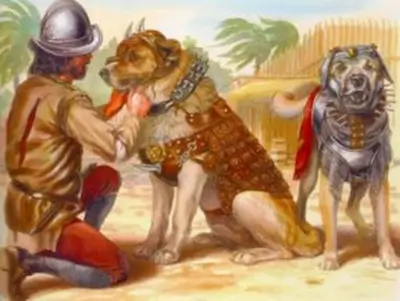 Early Mastiff Dogs of War
Early Mastiff Dogs of WarThere are countless descendants of the ancient mastiffs today, spread throughout many dog breeds.
As the Romans traveled into various regions, they often brought along their mastiffs which stimulated significant interest in these powerful dogs. This led to the breeding of distinct mastiff variations in many of these areas.
For instance, in Gaul, locals changed the Roman mastiffs into the Alpine Mastiff and later the St. Bernard.
The Rare Mastiff Dog Breeds
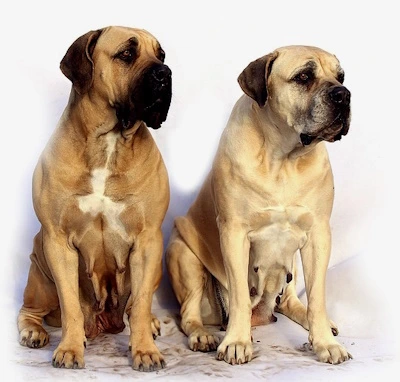 Mastiff Dogs courtesy Pixabay
Mastiff Dogs courtesy PixabayToday there are many mastiff breeds that are thriving, such as the St. Bernard, the Great Pyrenees and the Mastiff. But
there are also a number of mastiff breeds which are either nearly extinct or which have been revived and are
attempting a comeback.
Some of these breeds are known only in Europe. In some cases the breeds were wiped out by
World War I and II. In other cases, the numbers have simply dwindled due to a lack of breeders.
So let's explore some of the rare mastiff breeds we know about.
American Mastiff
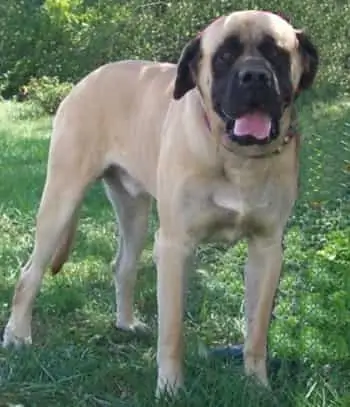 Courtesy M Parlier
Courtesy M ParlierThe American Mastiff dog breed (AM) originated in the United States and was,developed over several years through a cross of the English Mastiff and the Anatolian Mastiff resulting in a dog that can weigh up to 200 pounds or more.
The AM breed is registered with the Continental Kennel Club and has been recognized as a purebred breed by them since 2000.
Their overall appearance is that of
a massive, impressive-looking powerful dog
bearing a very similar resemblance to the English Mastiff.
While many may be overawed by an American Mastiff, this large dog is known to be
a very loyal and extremely family-oriented breed - getting along well with children being patient and gentle. Once socialized they will be friendly with family friends and guests.
Though not aggressive, as a family protector, the AM's commanding appearance, standing at 3 feet tall, would make any potential intruder think twice before proceeding.
Families interested in welcoming an American Mastiff puppy or rescue should ideally have plenty of space for exercise and play and be experienced dog owners - particularly with similar sized dog breeds. A list of breeders can be found here.
Because of the large size this dog will become, it's important that puppies be trained and well-socialized from an early age to accustom them to a wide variety of situations including people and other dogs.
Regarding health, the not uncommon issues, which an informed vet will know how to treat, include:
- not surprisingly- hip dysplasia
- and bloat
The average lifespan with good care is between 8 to 12 years.
Anatolian Shepherd Dog
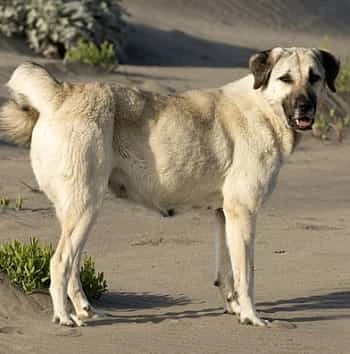 Courtesy Z Cebeci
Courtesy Z CebeciThe Anatolian Shepherd dog is descended from ancient mastiff breeds. He is primarily a livestock guarding dog with a strong independent nature.
Also known as
Anatolian Karabash and Turkish Shepherd Guard Dog, the breed originated in Turkey as far back as the Persian Empire.
Historically this breed has a long been recognized as a top mastiff-type flock guardian being renowned for their strong protective instincts and ability to fend off predators.
Anatolians have an affectionate nature and as family companions, one could not wish for a more loyal and protective dog. They get along well with children and other pets.
However, due to responsibilities of working for decades to protect their flocks, it is not surprising that they have acquired an independent streak along with the confidence needed to make decisions.
For this reason, they must be well-socialized and trained from an early age with a self-assured strong leader they can respect and bond with.
Socialization and consistent training are essential to most breeds to become solid citizens, but is especially crucial to large dominant dogs such as the Anatolian.
In terms of appearance, the Anatolian Shepherd dog is a very large, well-muscled and powerful-looking dog breed that can weight up to 150 pounds with a height of up to 30 inches. Along with a dense double coat, these sturdy dogs are ideally suited to perform their outside job duties.
Health: To maintain the overall good health of this breed:
- Provide high quality food and water at all times,
- Take him for daily walks,
- Routinely check ears and brush teeth.
- Arrange annual check-ups including dental inspection with a veterinarian.
While not commonly disposed to hip dysplasia and bloat, owners should be informed of these conditions just in case - especially to the latter which can be life threatening. Additionally, this breed may acquire an eyelid condition known as entropian. It is good for your vet to be familiar with these health notes as well as the breed's sensitivity to anesthesia - in case any procedures require this - such as teeth scaling.
For more extensive information about this very interesting breed I have created a separate page for the Anatolian Shepherd dog here.
Bullmastiff
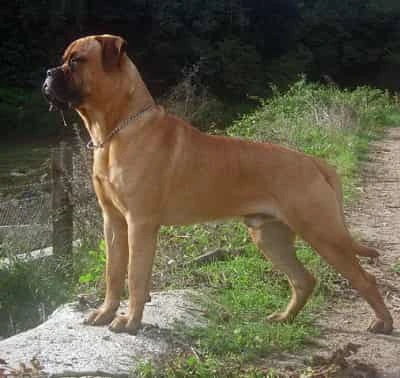 Courtesy F.Moreno
Courtesy F.MorenoThe Bullmastiff, one of the rare mastiff dog breeds, was developed in England during the 19th century and is believed to be a cross between two native breeds - the English Mastiff and the Bulldog.
William Burton of Thorneywood Kennels bred an early version of the Bullmastiff. One of his dogs, known as Thorneywood Terror, became famous at gamekeepers’ shows for his ability to catch any person willing to bet that he could escape from the dog. Even with the better being give a head star, the dog always caught and toppled the unfortunate gambler!
This mastiff breed is highly protective but not aggressive, fearless, intelligent, very strong and impressively agile for its large size.
Ultimately, these attributes were put to use in on large English estates where the Bullmastiff accompanied gamekeepers on night patrols to catch poachers and prevent the rustling of game which was pretty common at the time. While poaching was a very serious crime, many intruders were undeterred and the game wardens needed more protection in doing their job..
Enter: the Gamekeeper’s Night Dog as the Bullmastiff became known. A large muscular dog weighing up to 130 pounds and standing up to 27 inches is definitely capable of making quite an impression on potential trouble makers!
Today, having left his original job far behind him, the Bullmastiff dog breed has moved on to a less stressful role as a cherished family member. That being said, while Mastiffs make great family companions, being both gentle and affectionate, they do need early training and socialization due to their large size and protective nature.
Health issues common to large breeds include hip and elbow concerns as well as bloat – a very important condition to be aware of.
Overall care of the Bullmastiff includes regular exercise, sound nutrition, and veterinary check-ups on an annual basis to maintain health and a contented life.
The Bullmastiff breed was recognized by the AKC in 1934.
Cane Corso
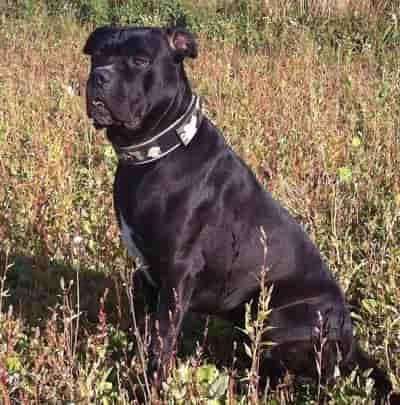 Courtesy Creative Commons
Courtesy Creative CommonsThe Cane Corso, also referred to as the Italian Mastiff, is a breed which originated in Italy with a history that goes back to Roman times To be clear, this breed is the result of Italian native dog breeds crossed with Mollosus (mastiff) type dogs obtained during the Roman occupation of the Greek Islands.
Subsequently, after all the fighting was over in the Western Empire, the dogs took on other jobs around farmhouses including herding or guarding cattle and pigs, wild boar hunting, as well as protecting their owners property.
Overtime, their numbers diminished greatly that they almost vanished, but were brought back from near extinction by a group of fanciers in the 1970s. A Society of Cane Corso Lovers was formed in 1983.
Appearance: The Cane Corso has a short dense coat seen in black, gray, fawn, or brindle. The breed is very muscular and can weigh between 100-120 pounds with a height of up 28 inches tall at the withers. Their ears are often cropped.
Characteristics: A loyal and protective breed that likes to keep in close touch with their owners and other family members most of the time. This also means, they don't like being left alone!
Training
can be pretty straightforward if an owner has a strong background in dog training because the CC is very intelligent but can have the tendency to try to take charge. The solution to this tendency is an experienced owner to provide firm guidance and thoroughly socialize the Cane Corso to build their comfort level around people, places and multiple situations - from a very early age.
Daily Activity: In addition to a large outdoor area for play, exercise and training, the CC should be taken out for daily walks for his well-being of mind and body.
Health: Overall the Cane Corso is considered a fairly healthy breed. That being said, there are some health issues associated with them. Those include:
- Hip dysplasia,
- Idiopathic Epilepsy,
- Mange,
- Eyelid issues, and
- Bloat, owners need to know the signs of this life threatening condition
AKC Recognition: The Cane Corso Came to America in 1988, and in 2010 the breed was recognized by the AKC as part of the Working Group of dogs, or Mollosus breeds .
Dogue de Bordeaux
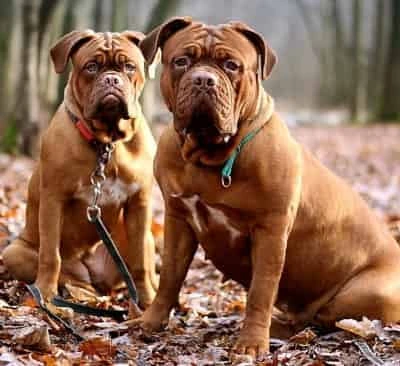 Courtesy Pixabay
Courtesy PixabayOriginating in France, the Dogue de Bordeaux (DDB), is a large breed originally used as guard dogs and later to drive cattle as well as for hunting purposes.
The breed also goes by other names including the Bordeaux Mastiff or French Mastiff and is generally considered to be one of the oldest of the mastiffs.
Appearance: The Dogue de Bordeaux is a very powerful dog with males weighing from 110 pounds or much more and standing up to 27 inches at the withers.
The DDB has a short attractive coat that is seen in shades of fawn, with a furrowed forehead and thick, low hanging jowls.
Characteristics: Despite their formidable appearance, Dogue de Bordeauxs are generally gentle and affectionate with their families.
They are loyal, protective, and often described as "nanny dogs" due to their love for children. However, they can be stubborn and require a confident leader who can provide firm and consistent training from an early age.
Proper socialization is also important to ensure they are comfortable in a variety of situations, places, around strangers and of course other dogs.
Dogue de Bordeauxs require a lot of space and exercise to stay healthy and happy.
Health issues that may affect them during their lifetime include hip dysplasia and heart conditions, which can be managed through regular veterinary care .and proper nutrition.
Sadly, they have a relatively short life of between 5-8 years.
Overall, the Dogue de Bordeaux is a loyal and devoted companion for the right owner who is willing to provide the care and attention they require.
The breed
was recognized by the AKC in 2008.
English Mastiff
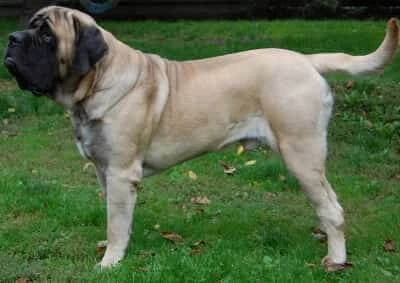 Westgort by R.Rohovsky
Westgort by R.RohovskyA breed of dog in the Molosser group originating in England, usually just called "Mastiff".
The English Mastiff is one of the oldest dog breeds with a history dating back to ancient times. The breed was originally used as a guard dog and for hunting large game.
At one time the EM was used for bear-baiting, bull-baiting, dog fighting and even lion-fighting.
By the end of World War I the breed became extinct outside the UK. Since that time, the breed has become much more popular in the U.S. and around the world.
Appearance: English Mastiffs are very large, with males typically weighing between 160-230 pounds and standing up to 30 inches tall at the shoulder. They have an impressive size head with a short muzzle, droopy jowls, and a wrinkled forehead.
Their coat is short, smooth and tight to the body. Colors seen in the coat include apricot-fawn, silver-fawn, fawn, or dark fawn-brindle
Characteristics: Despite their commanding appearance and size, the EM is generally a gentle and affectionate dog around their families. They are loyal, protective, and often described as "gentle giants".
However, there is a bit of a stubborn streak in the breed which can be counteracted in the hands of a firm yet fair leader who can provide consistent training from an early age.
Proper socialization is an important part of the EM's handling to make sure they are comfortable around strangers and other dogs.
Space Needs: As can be expected, the English Mastiff's large size is best suited to a lot of space where he can get some daily exercise in addition to daily walks.
Healthwise, the issues the EMs may encounter during their lifetime include, not surprisingly: hip dysplasia and bloat, The latter is a very serious issue which you can learn more about here.
The English Mastiff has an average lifespan of about 7 years, but some have lived much longer. One record exists of an EM named Kush living to age 15.
Proper veterinary care and good nutrition definitely plays an important part in raising a healthy Mastiff.
Great Dane
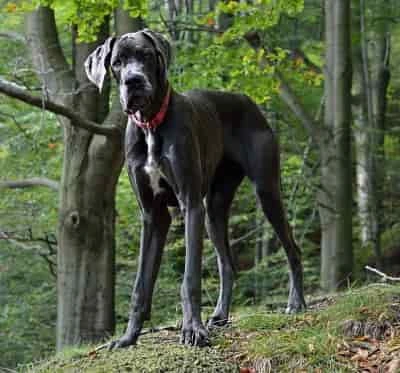 Great Dane credit Pixabay
Great Dane credit PixabayThe Great Dane is an old breed that traces its history back to 3,000 B.C where similar “mastiff” type dogs were depicted artifacts and writings.
At that time, the GDs, prized for their fearless nature, strength and boldness were used as war dogs as well as for hunting boar and guarding property.
Over time, both their appearance and demeanor changed considerably as a result of being selectively bred in different countries
The Great Dane, as we know it today originated in Germany. and is also known as the German Mastiff. and Grand Danois in French.
It is speculated that the development of the GD resulted from a cross between the Mastiff and the Irish Wolfhound. The secondary influence was from the greyhound which gave the Great Dane is regal and svelte appearance.
The United States began importing dogs, primarily from Germany and eventually a specialty breed club was organized in 1889, which evolved into The Great Dane Club of America in 1891.
Appearance:
Great Danes are not only elegant they are also among the largest dog breeds, with males weighing between 120-200
pounds and standing up to 32 inches tall at the shoulder.
They have a sleek, muscular build with a long, narrow head and floppy ears. Their coat is short and comes in a variety of colors, including black, blue, fawn, brindle, and harlequin.
Characteristics: Although they are impressively large, Great Danes are known for being gentle and affectionate with their families, and they are often referred to as "gentle giants".
They are generally good with children and other pets, and they tend to have a laid-back and calm temperament.
However, they do require proper socialization and training from an early age to ensure they are well-behaved around strangers and other dogs.
Exercise Needs:
Great Danes require regular exercise and space to roam, but they are generally considered low-energy dogs. They enjoy leisurely walks and playtime but are also content to lounge around the house with their owners.
Due to their size, it's important to avoid overexertion, especially during their growth phase, to protect their developing joints.
Health: The Great Dane is prone to certain health issues.
These include: Hip dysplasia and bloat, which can be managed through regular veterinary care and proper nutrition.
Overall:
The Great Dane is a gentle and affectionate breed that can make a great companion for the right family with enough space and time to devote to their care.
Japanese Mastiff
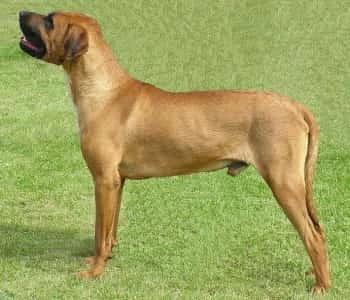 Courtesy L.Houdas
Courtesy L.HoudasAll of the rare mastiff dog breeds are very big muscular dogs as we know, but this one stands out as being extra large.
Origins and Appearance:
The Japanese Mastiff,
also known as Tosa Inu, originated in Japan. They were originally bred for dog fighting
in the late 19th century, but
today they are primarily kept as companion dogs in their home country and around the world.
The Japanese Mastiff is not only powerful, but can weigh as much as 200 pounds and stands up to 32 inches tall at the shoulder.
They have a short, dense coat that comes in a variety of colors, including red, fawn, brindle, and black. They have a large head with a strong jaw, and their ears are often cropped for aesthetic purposes.
Characteristics:
The Tosa Inu is an alert, intelligent dog known to be both fearless and courageous while having a calm disposition, Due to their history as fighting dogs, Japanese Mastiffs can be wary of strangers and other dogs.
They require a firm and experienced owner who can properly train and socialize them from an early age. Despite their history, they are generally loyal and affectionate with their families, and they are known for quiet nature.
Exercise Needs:
Japanese Mastiffs
require daily long walks, mixed in with a little dog play, as well as mental stimulation,
and space to roam in a securely fenced area, But they are generally
low-energy dogs that are happy to lounge around the house with their
owners.
Health:
The Japanese Mastiff has a lifespan of up to 12 years, but the average is around 10 years. They are also prone to certain health issues common to many large dogs, such as hip
dysplasia, elbow dysplasia and bloat, which can be managed through regular veterinary
care and proper nutrition.
They may also encounter problems with skin conditions such as rashes along with allergic seasonal environmental reactions such as sneezing and itching
Overall:
The
Japanese Mastiff is a powerful and protective breed that requires a
responsible and experienced owner who can provide the training,
exercise, and socialization they need to thrive. They can make a
great companion for the right family, but they are not recommended
for novice dog owners or homes with small children or other pets.
Neapolitan Mastiff
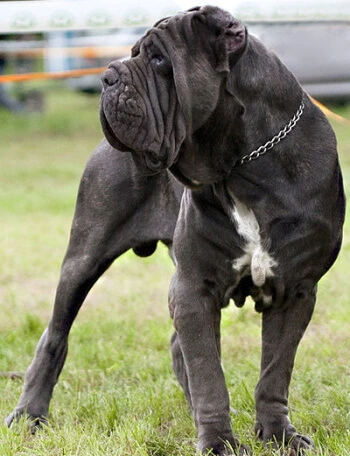 Courtesy E.Ziemska
Courtesy E.ZiemskaThe Neapolitan Mastiff, is a very ancient mastiff dog breed with its origins in Italy though it could well be descended from the Molosser dog of ancient Greece.
Whatever the case, these powerful dogs
ended up in the Roman Empire
at some point
and fought alongside Roman legions.
Appearance:
Neapolitan Mastiffs
are typically large and muscular, with males weighing up to 200
pounds and standing up to 30 inches tall at the shoulder.
They have a smooth coat that is short and dense. Coat colors include: black, blue, mahogany, and tawny.
The size of their head and neck can only be described awesome. Heavy wrinkles and folds abound around the muzzle and need regular grooming attention. The ears are often cropped for aesthetic purposes.
Be aware that Neopolitan Mastiffs are heavy droolers.
Background:
The Neapolitan
Mastiff, also known as the Mastino Napoletano in his native country, faced near starvation and extinction at one time due to wars and lack of food.
Fortunately, through the efforts of fanciers, the breed
was rediscovered in Italy in the 1940s and brought back to be enjoyed again.
Due to their history as guard dogs, Neapolitan Mastiffs can be naturally protective of their families and may be wary of strangers. They require a firm and experienced owner who can properly train and socialize them from an early age.
That being said, in general, they are known to be loyal and affectionate with their families and have a calm and patient demeanor.
Exercise and Health:
Neapolitan Mastiffs
require plenty of exercise and space to roam, but they are generally
low-energy dogs that are happy to lounge around the house with their
owners.
While being considered a hardy breed with a lifespan of 7 to 10 years, they are disposed to a few health conditions. These include hip dysplasia - common to many large breeds -, cherry eye and bloat. Of these, bloat is very serious and can be life threatening. Quick action with a trusted veterinarian is needed.
The Neo was originally bred as a guard dog and primarily protected estates, homes, and livestock. Today, they are mostly kept as companion dogs and are known for their loyalty and protective nature. They can make a great companion for the right family, but they are not recommended for novice dog owners or homes with small children or other pets.
AKC Recognition:
The Neopolitan Mastiff breed was recognized by the AKC as part of the
Working Group of dogs in 2004.
Pyrenean Mastiff
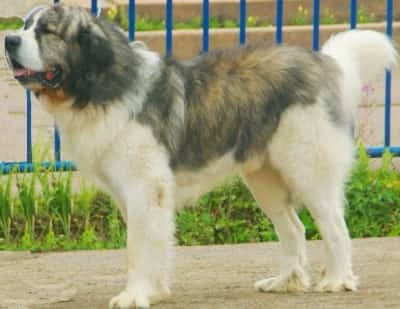 Courtesy Canarian
Courtesy CanarianDeveloped as a livestock guardian breed from the Spanish Pyrenees. Intensely loyal, brave and intelligent, and as rugged as the terrain from which he originated!
South African Mastiff
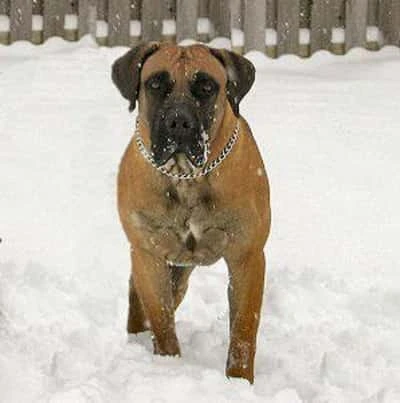 By hunthillboerboels.com
By hunthillboerboels.comAlso known as Boerboel, a breed of dog originating in South Africa. A farmers dog used to guard the homestead.
Spanish Mastiff
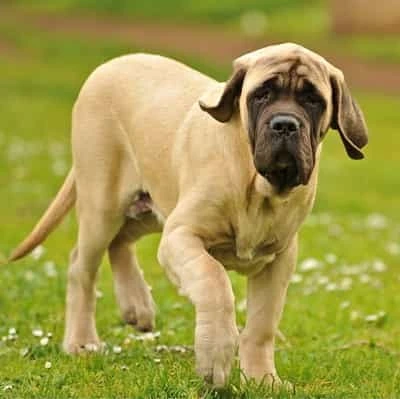 Courtesy C.Gennari
Courtesy C.GennariThe Spanish Mastiff, also known as the Mastín Español or the Mastín Leonés is an ancient breed of dog originating in Spain. It is one of the oldest mastiffs dating back over 2000 years.
Originally bred to be livestock guardian dogs and guardians defending flocks and herds of sheep and other livestock from wolves, bears and other predators.
Today, they are still primarily used as working dogs, but this gentle giant has also become popular as very affectionate family companions.
The Spanish mastiff was recorded in the America Kennel Club Foundation Stock Service in 2008, and is assigned to the Working Dog Group.
Outside of Spain they are a relatively uncommon breed.
Appearance of the Spanish Mastiff Dog Breeds
Spanish Mastiffs are very large in size, powerful and strongly built. Their head is broad coupled with a strong jaw and floppy ears.
Weight:They can weigh up to 200
pounds
Height:
Standing height from the shoulder is 28 to 35 inches
The coat is thick and dense. Among the variety of coat colors that may be seen are: fawn, brindle, red, grey, yellow and black.
One thing to keep in mind is that the Spanish Mastiff is prone to drooling so clean up cloths are a necessity.
Spanish Mastiffs With Family
Based on the Spanish Mastiff's history as a working breed, it is not surprising that protecting their family comes naturally to them. This large breed is very confident and aware of its power when it comes to potential threats.
While the SMs are
not frequent barkers, they will use their their commanding loud bark to
alert you to unusual situations or approaching strangers. I think this
would also tend make visitors take a wait and see approach!
They have a moderately good reputation with children as well as other pets
Spanish Mastiffs have a calm and patient demeanor and without doubt are very loyal and affectionate with their families.
Training
Because the Spanish Mastiff is a powerful and protective breed, training is vitally important starting from an early age.
They require a firm and experienced owner who can properly train and thoroughly socialize with positive renforcement methods from an early age. Well-rounded socialization that exposed them to people, places, situations, as well as other dogs, will help balance their protective nature.
This will ensure they become the great companions you want them to be.
Potential owners are advised to research and understand the breed thoroughly before inviting one into their home. They can make a great companions for the right family, but they are not recommended for novice dog owners and do best in homes without small children or other pets. Older children, familiar with and respectful of, pets are an exception.
Exercise and Health
Spanish Mastiffs should have more than one daily walk as well as other forms of exercise including outdoor games, in a fenced area which ideally gives them space to roam. Other ways to provide more activity include swimming, hiking, and dog sports like agility.
In the home but they are generally mellow dogs that are happy to lounge around the house with their owners.
Spanish Mastiffs are associated with certain health issues, such as hip dysplasia and bloat, which can be managed through regular veterinary care and proper nutrition.
Expected lifespan is 10-12 years with good care.
Spanish Mastiff - Takeaway
Before deciding on this large breed dog for your family, do thorough research so you don't miss any of the important details. Try to have converations with others who have had a Spanish Mastiff or are very well-informed about the breed.
Be sure you can accept a dog that drools!
Tibetan Mastiff
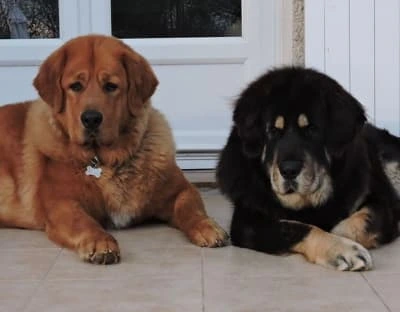 Courtesy Brunodesola
Courtesy BrunodesolaAn ancient breed of dog originating in Tibet. They are one of the oldest mastiffs and the ancestors of Tibetan Mastiffs may be the ancestors of all mastiffs.
They are kept
as a guardian of herds, flocks, the home and family
and, in Tibet, are tied outside the home during the day and allowed to
run loose at night to protect the property. The Tibetan Mastiff is
considered a primitive breed.
The Tibetan Mastiff is one breed that is very expensive to acquire. In
March of 2011, it was reported that a TM named Hong Dong was purchased
by a wealthy gentleman in China for the sum of $1.52 million! Obviously
this rare breed is not one that many individuals could afford.
Fila Brasileiro
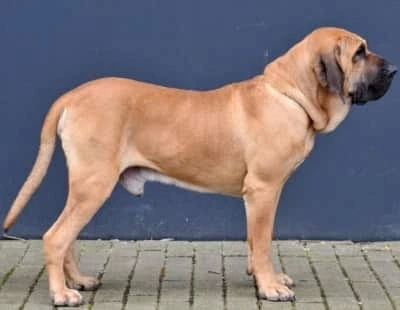 By Doglover
By DogloverThis breed, otherwise known as the Brazilian Mastiff, is an estate guardian dog from Brazil.
Extinct Mastiff Dog Breeds
Cuban Mastiff
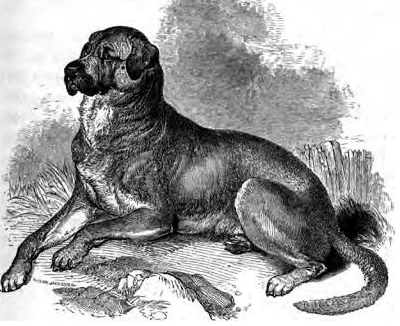 Cuban Mastiff - Wikipedia
Cuban Mastiff - WikipediaThe Cuban Mastiff, also known as Dogo Cubano, Cuban Bloodhound or Cuban Bullmastiff, is an extinct breed which existed in the early 1800's.
It was developed in Cuba from bulldogs, mastiffs and cattle dogs which resulted inthe breed bearing a resemblance to the Bullmastiff.
This breed was mainly used to guard properties or as watchdogs and there is some indication they may have participated in bull-baiting or dog fighting as it fits into the profile of dogs in these type activities.
According to Wikipedia, the breed was introduced into Cuba to capture runaway slaves. Subsequently, when slavery was abolished, they ceased to exist.
Alpine Mastiff
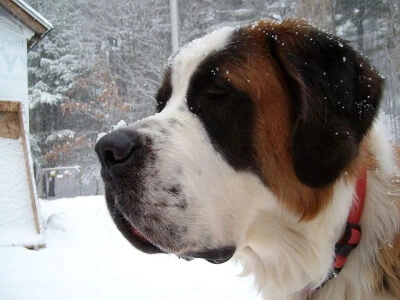 Creative Commons image
Creative Commons imageA breed originating in Switzerland that became extinct during the 19th century.
This breed bears a strong relationship with some of today's mastiff breeds. It was also among those which contributed to the development of the St. Bernard.
Fast Forward
Overall, the rare mastiff dog breeds are enjoying a great deal of interest today.
There are efforts to keep these breeds alive and people interested in owning them all over the world.
The Internet has made it much easier to find out about about these dogs and to contact breeders so hopefully no more rare mastiff dog breeds will become extinct.
Before You Go...
If you like the content of this page, as well as others on my site, please give it some love by clicking on the heart in the lower right hand corner. This helps me to keep providing enjoyable and useful content.
Thank you
Image Credits
- https://commons.wikimedia.org/wiki/File:AlpineMastiff0077.JPG License: https://creativecommons.org/licenses/by/3.0 CC BY
- American Mastiff: https://commons.wikimedia.org/wiki/File:AM.Suma.jpg License: https://creativecommons.org/licenses/by-sa/3.0 CC BY-SA
- https://commons.wikimedia.org/wiki/File:Anatolian_Shepherd_Dog_01.jpg License: https://creativecommons.org/licenses/by-sa/4.0 CC BY-SA
- https://commons.wikimedia.org/wiki/File:Bullmastiff_edited.JPG License: http://creativecommons.org/licenses/by-sa/3.0/ CC BY-SA
- https://commons.wikimedia.org/wiki/File:Cane_corso.jpg License: https://creativecommons.org/licenses/by-sa/3.0/ CC BY-SA
- Dog de Bordeaux from pixabay.com
- English Mastiff: https://commons.wikimedia.org/wiki/File:Westgort_Anticipation_17_months.JPG License: https://creativecommons.org/licenses/by-sa/3.0 /CC BY-SA
- Brazilian Mastiff: https://commons.wikimedia.org/wiki/File:Yacare_De_El_Siledin.JPG License: https://creativecommons.org/licenses/by/3.0 /CC BY-SA
- Great Dane from pixabay.com
- Tosa Inu dog - Japanese Mastiff; https://commons.wikimedia.org/wiki/File:BUKADAI_2.jpg title=via WikimediaCommons BUKADAI..JPG: Ludivine HOUDASderivative work: Caronna License: https://creativecommons.org/licenses/by-sa/3.0 /CC BY-SA
- Neapolitan Mastiff: https://commons.wikimedia.org/wiki/File:Mastino_sylwetka.jpg License: https://creativecommons.org/licenses/by-sa/3.0 /CC BY-SA
- https://commons.wikimedia.org/wiki/File:Pyrenean_Mastiff.JPG License: https://creativecommons.org/licenses/by-sa/3.0>CC BY-SA
- Spanish Mastiff: https://commons.wikimedia.org/wiki/File:Pluto_as_Dumbo_..._(3341583025).jpg License: https://creativecommons.org/licenses/by/2.0 CC BY
- https://commons.wikimedia.org/wiki/File:DOGUE_DU_TIBET_TIBETAN_MASTIFF_DO-KHY.JPG License: https://creativecommons.org/licenses/by-sa/4.0 CC BY-SA
- https://commons.wikimedia.org/wiki/File:136._Cuban_Mastiff.JPG
